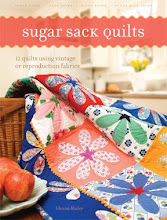 Hi Everyone! As you probably know, I'm still selling feedsacks and rickrack like a mad woman! And I remembered that I'd talk to you a bit about caring for feedsacks, so here I go!
Hi Everyone! As you probably know, I'm still selling feedsacks and rickrack like a mad woman! And I remembered that I'd talk to you a bit about caring for feedsacks, so here I go!First of all, if you ever find feedsacks that are "perfect", it'll be few and far between. I seldom find one that doesn't have at least some staining and a few peck or pull holes. What are those you say?
Remember that many of these sacks were taken to the coop or the barn and possibly thrown on the floor where the chickens could get to them and peck at them to get a nibble! Hence, you have a "peck hole". Or when the strings were being removed, they might be pulled a little too hard and you'll get a "pull hole". So there you are!
The good news is that I believe that they must have used steel in the manufacturing of these things! Not really, but they are VERY durable! I wash all my vintage fabric when it comes into my house for a couple of reasons. First, you never know what you're bringing in with it! And secondly, since I sell so much, I want to make sure that the fabrics are stable, both in color and strength. My stain remover of choice is OXYCLEAN. This stuff is fabulous! It takes those stains away and doesn't fade the color. I love it!
 For feedsacks, I usually use a 5 gallon paint bucket. I fill it up with hot water and put 1 heaping big scoop full of Oxyclean in and swish it around till it's dissolved. Then I add 12-14 feedsacks. I let them soak 24 hours!! The biggest problem I find is when folks don't use enough product or they don't soak long enough. So don't be stingy with your Oxyclean OR time!!
For feedsacks, I usually use a 5 gallon paint bucket. I fill it up with hot water and put 1 heaping big scoop full of Oxyclean in and swish it around till it's dissolved. Then I add 12-14 feedsacks. I let them soak 24 hours!! The biggest problem I find is when folks don't use enough product or they don't soak long enough. So don't be stingy with your Oxyclean OR time!!When that's done, take out the sacks and wash them in your washer with your favorite detergent. No, don't put them on gentle, or be afraid to agitate them! I'm telling you, they are made with steel!! Run them through the full cycles and throw them in the dryer! Yes, the dryer! You will be amazed at how beautifully they come out. If, by chance, after all that, they still have some light staining, then soak 1 or 2 at a time in a plastic dishpan with a couple of heaping tablespoons of Oxyclean for another 24 hours. If the stain is still not out, you'll have to live with it. But hey, if you're cutting them up, no big deal, right??
I generally store them without ironing them because I'd just have to do it again later. You've seen my sewing room so you know that I keep my stuff on open shelves. That's partly because I don't have much natural light in there. I don't think feedsacks fade easily, but if I had lots of light coming in, I might consider covering my shelves. Not just for those, but all my fabrics.
So there you have it! The one thing I always stress to the audience when speaking about feedsacks is to USE them! I inevitably hear someone say "I have a whole stack of these, but I just can't cut them!" My response is "Well, then, sell them to me!" I'm just a believer in using what you have, but if you just want to look at them and fondle them, I guess that's OK, too. In any case, enjoy!
Blessings~






























































